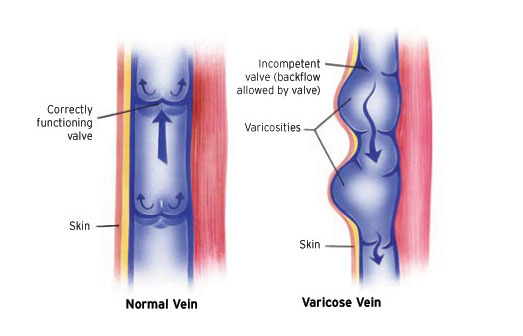Remember back to your days learning the human body at school. You’ll likely recall veins, arteries, capillaries and the general role the blood vessels play within the body; delivering oxygen and nutrients to the various muscles and organs. But did you know that you have both superficial veins and deep veins? And each is important for performing a different function. So, what’s the difference? And can either type develop into varicose veins? We’re here to answer all your questions!
What are superficial veins?
While the name may be misleading, these aren’t veins that care more about their appearance or having the latest in fashion trends. Superficial veins are those that are closer to the surface of your body. In fact, they sit just on top of the fatty layer underneath your skin.
Superficial veins are normally visible to the naked eye, especially during exercise and physical strain. Weaving throughout your body and interconnected with the deeper veins in your body, these blood vessels act to keep your body cool when it overheats.
About 10 per cent of the blood flow in your legs is directed through superficial veins.
What are deep veins?
Deep veins are the ones that are closer to the core of your body. Sitting in the muscles and alongside the bones, deep veins are most often paired with arteries in the same area (unlike superficial veins which don’t have any arteries alongside them).
Deep veins do most of the hardwork and are responsible for about 90 per cent of the blood flow back to your heart. Deep varicose veins don’t often show clear symptoms, but if you’re feeling a heaviness in your legs or swelling around your ankles, especially at the end of the day, it’s good to get them checked.
Learn more: Why do my legs feel heavy at the end of the day?
Can both become varicose veins?
Both deep veins and superficial veins are at risk of becoming varicose veins. Their appearance is different, however, as superficial veins can tend to bulge and knot under the skin, causing a rope-like appearance. Deep varicose veins can still twist inside the body, but this isn’t visible without specialised imaging equipment.
Treatment of the superficial veins is generally a quick and fairly simple procedure.
However deep varicose veins can be difficult to treat, particularly if they’re leaking. For this reason, it’s crucial for anyone at higher risk to seek treatment for their veins.
A good way to understand how varicose veins affect your legs is to think of the veins as a sewerage system, sending blood back up to the heart through various pipes around the body. The deeper veins are the main pipes running to the heart, while the superficial veins are the smaller pipes that branch off and re-join them. Even if one pipe gets blocked (varicose veins), the rest are still working, just not as effective.
It’s also important to note that while superficial varicose veins can cause complications, the presence of deep varicose veins can indicate more serious issues and lead to sometimes irreversible damage if untreated.
If you’ve developed deep varicose veins, it’s best to speak to your GP or vein specialist about preventing more serious issues like DVT (deep vein thrombosis) and chronic venous insufficiency, particularly if you match any of the following
- Are obese or heavily overweight
- Are a smoker
- Have a family history of varicose veins
Seek expert advice
The doctors at The Vein Institute specialise in varicose vein treatment. We offer patients a comprehensive program using non-surgical laser treatment techniques.
The benefits of non-surgical varicose vein treatment are:
- Walk-in walk-out treatment
- 98% success rate
- Extremely effective
- Can be performed at a clinic (no hospitalisation)
- No general anaesthetic
- Medicare rebates apply
- No downtime or time away from work
Call us on 0420 102 637, or fill out our booking request form.
See more vein facts: Answering Your Vein FAQs



